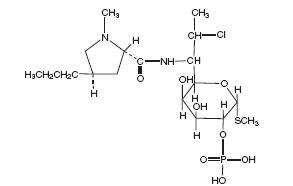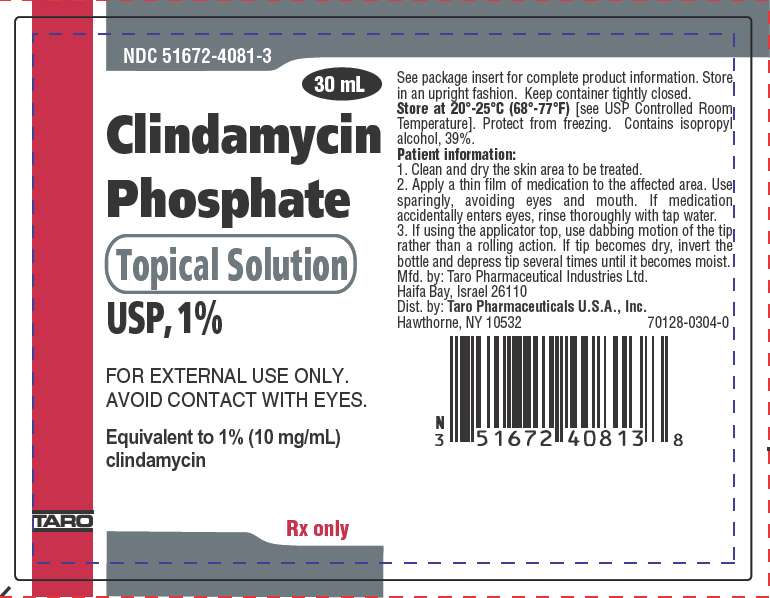Clindamycin Phosphate
Taro Pharmaceuticals U.S.A., Inc.
Clindamycin PhosphateTopical Solution USP, 1%
FULL PRESCRIBING INFORMATION: CONTENTS*
- CLINDAMYCIN PHOSPHATE DESCRIPTION
- CLINICAL PHARMACOLOGY
- CLINDAMYCIN PHOSPHATE INDICATIONS AND USAGE
- CLINDAMYCIN PHOSPHATE CONTRAINDICATIONS
- WARNINGS
- PRECAUTIONS
- CLINDAMYCIN PHOSPHATE ADVERSE REACTIONS
- OVERDOSAGE
- CLINDAMYCIN PHOSPHATE DOSAGE AND ADMINISTRATION
- HOW SUPPLIED
- PRINCIPAL DISPLAY PANEL - 30 mL Bottle Label
FULL PRESCRIBING INFORMATION
Rx only
For External Use
CLINDAMYCIN PHOSPHATE DESCRIPTION
Clindamycin Phosphate Topical Solution contains clindamycin phosphate, USP, at a concentration equivalent to 10 mg clindamycin per milliliter.
Clindamycin phosphate is a water-soluble ester of the semi-synthetic antibiotic produced by a 7(S)-chloro-substitution of the 7(R)-hydroxyl group of the parent antibiotic lincomycin.
The solution contains isopropyl alcohol 39% w/v, propylene glycol, and purified water. May contain sodium hydroxide for pH balance.
The structural formula is represented below:

The chemical name for clindamycin phosphate is Methyl 7-chloro-6,7,8-trideoxy-6-(1-methyl-trans-4-propyl-L-2-pyrrolidinecarboxamido)-1-thio-L-threo-(α)-D-galacto-octopyranoside 2-(dihydrogen phosphate).
CLINICAL PHARMACOLOGY
Although clindamycin phosphate is inactive in vitro, rapid in vivo hydrolysis converts this compound to the antibacterially active clindamycin.
Cross resistance has been demonstrated between clindamycin and lincomycin.
Antagonism has been demonstrated between clindamycin and erythromycin.
Following multiple topical applications of clindamycin phosphate at a concentration equivalent to 10 mg clindamycin per mL in an isopropyl alcohol and water solution, very low levels of clindamycin are present in the serum (0-3 ng/mL) and less than 0.2% of the dose is recovered in urine as clindamycin.
Clindamycin activity has been demonstrated in comedones from acne patients. The mean concentration of antibiotic activity in extracted comedones after application of Clindamycin Phosphate Topical Solution for 4 weeks was 597 mcg/g of comedonal material (range 0-1490). Clindamycin in vitro inhibits all Propionibacterium acnes cultures tested (MICs 0.4 mcg/mL). Free fatty acids on the skin surface have been decreased from approximately 14% to 2% following application of clindamycin.
CLINDAMYCIN PHOSPHATE INDICATIONS AND USAGE
Clindamycin Phosphate Topical Solution is indicated in the treatment of acne vulgaris. In view of the potential for diarrhea, bloody diarrhea and pseudomembranous colitis, the physician should consider whether other agents are more appropriate. (See CONTRAINDICATIONS, WARNINGS and ADVERSE REACTIONS sections.)
CLINDAMYCIN PHOSPHATE CONTRAINDICATIONS
Clindamycin Phosphate Topical Solution is contraindicated in individuals with a history of hypersensitivity to preparations containing clindamycin or lincomycin, a history of regional enteritis or ulcerative colitis, or a history of antibiotic-associated colitis.
WARNINGS
Orally and parenterally administered clindamycin has been associated with severe colitis which may result in patient death. Use of the topical formulation of clindamycin results in absorption of the antibiotic from the skin surface. Diarrhea, bloody diarrhea, and colitis (including pseudomembranous colitis) have been reported with the use of topical and systemic clindamycin.
Studies indicate a toxin(s) produced by clostridia is one primary cause of antibiotic-associated colitis. The colitis is usually characterized by severe persistent diarrhea and severe abdominal cramps and may be associated with the passage of blood and mucus. Endoscopic examination may reveal pseudomembranous colitis. Stool culture for Clostridium difficile and stool assay for C. difficile toxin may be helpful diagnostically.
When significant diarrhea occurs, the drug should be discontinued. Large bowel endoscopy should be considered to establish a definitive diagnosis in cases of severe diarrhea.
Antiperistaltic agents such as opiates and diphenoxylate with atropine may prolong and/or worsen the condition. Vancomycin has been found to be effective in the treatment of antibiotic-associated pseudomembranous colitis produced by Clotridium difficile. The usual adult dosage is 500 milligrams to 2 grams of vancomycin orally per day in three to four divided doses administered for 7 to 10 days. Cholestyramine or colestipol resins bind vancomycin in vitro. If both a resin and vancomycin are to be administered concurrently, it may be advisable to separate the time of administration of each drug.
Diarrhea, colitis, and pseudomembranous colitis have been observed to begin up to several weeks following cessation of oral and parenteral therapy with clindamycin.
PRECAUTIONS
General
Clindamycin Phosphate Topical Solution contains an alcohol base which will cause burning and irritation of the eye. In the event of accidental contact with sensitive surfaces (eye, abraded skin, mucous membranes), bathe with copious amounts of cool tap water. The solution has an unpleasant taste and caution should be exercised when applying medication around the mouth.
Clindamycin Phosphate should be prescribed with caution in atopic individuals.
Drug Interactions
Clindamycin has been shown to have neuromuscular blocking properties that may enhance the action of other neuromuscular blocking agents. Therefore it should be used with caution in patients receiving such agents.
Pregnancy
Teratogenic Effects -- Pregnancy Category B
Reproduction studies have been performed in rats and mice using subcutaneous and oral doses of clindamycin ranging from 100 to 600 mg/kg/day and have revealed no evidence of impaired fertility or harm to the fetus due to clindamycin. There are, however, no adequate and well-controlled studies in pregnant women. Because animal reproduction studies are not always predictive of human response, this drug should be used during pregnancy only if clearly needed.
Nursing Mothers
It is not known whether clindamycin is excreted in human milk following use of Clindamycin Phosphate Topical Solution. However, orally and parenterally administered clindamycin has been reported to appear in breast milk. Because of the potential for serious adverse reactions in nursing infants, a decision should be made whether to discontinue nursing or to discontinue the drug, taking into account the importance of the drug to the mother.
Pediatric Use
Safety and effectiveness in pediatric patients under the age of 12 have not been established.
Geriatric Use
Clinical studies for Clindamycin Phosphate Topical Solution did not include sufficient numbers of subjects aged 65 and over to determine whether they respond differently from younger subjects. Other reported clinical experience has not identified differences in responses between the elderly and younger patients.
CLINDAMYCIN PHOSPHATE ADVERSE REACTIONS
In 18 clinical studies of various formulations of Clindamycin Phosphate Topical Solution using placebo vehicle and/or active comparator drugs as controls, patients experienced a number of treatment emergent adverse dermatologic events [see table below].
| Treatment Emergent Adverse Event | Solution n=553 (%) |
Gel n=148 (%) |
Lotion n=160 (%) |
|||
|---|---|---|---|---|---|---|
| # not recorded | ||||||
| Burning | 62 | (11) | 15 | (10) | 17 | (11) |
| Itching | 36 | (7) | 15 | (10) | 17 | (11) |
| Burning/Itching | 60 | (11) | # | (-) | # | (-) |
| Dryness | 105 | (19) | 34 | (23) | 29 | (18) |
| Erythema | 86 | (16) | 10 | (7) | 22 | (14) |
| Oiliness/Oily Skin | 8 | (1) | 26 | (18) | 12 |
(10) |
| Peeling | 61 | (11) | # | (-) | 11 | (7) |
Orally and parenterally administered clindamycin has been associated with severe colitis which may end fatally.
Cases of diarrhea, bloody diarrhea and colitis (including pseudomembranous colitis) have been reported as adverse reactions in patients treated with oral and parenteral formulations of clindamycin and rarely with topical clindamycin (see WARNINGS section.)
Abdominal pain and gastrointestinal disturbances as well as gram-negative folliculitis have also been reported in association with the use of topical formulations of clindamycin.
OVERDOSAGE
Topically applied Clindamycin Phosphate Topical Solution can be absorbed in sufficient amounts to produce systemic effects. (See WARNINGS section.)
CLINDAMYCIN PHOSPHATE DOSAGE AND ADMINISTRATION
Apply a thin film of Clindamycin Phosphate Topical Solution twice daily to affected area.
Keep all liquid dosage forms in containers tightly closed.
HOW SUPPLIED
Clindamycin Phosphate Topical Solution USP, 1% containing clindamycin phosphate equivalent to 10 mg clindamycin per milliliter is available in the following sizes:
1 oz (30 mL) applicator bottle…………….…NDC 51672-4081-3
2 oz (60 mL) applicator bottle……………….NDC 51672-4081-4
Store at 20°-25°C (68°-77°F) [see USP Controlled Room Temperature].
Protect from freezing.
Mfd. by: Taro Pharmaceutical Industries Ltd., Haifa Bay, Israel 26110
Dist. by: Taro Pharmaceuticals U.S.A., Inc., Hawthorne, NY 10532
Revised: June, 2013
70126-0613-1 386
PRINCIPAL DISPLAY PANEL - 30 mL Bottle Label
NDC 51672-4081-3
30 mL
Clindamycin
Phosphate
Topical Solution
USP, 1%
FOR EXTERNAL USE ONLY.
AVOID CONTACT WITH EYES.
Equivalent to 1% (10 mg/mL)
clindamycin
TARO
Rx only

Clindamycin PhosphateClindamycin phosphate SOLUTION
| ||||||||||||||||||||||||||||||||||||||||||||||||||||||||||||||||||||||